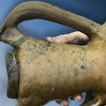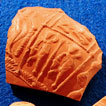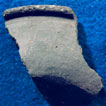Roman Trade
In the pre-Roman Iron Age, we have very little evidence for any sort of trade. After the conquest our area, especially the legionary fortress at Caerleon, was linked into trading networks that reached across the empire and beyond.
Archaeologists rely heavily on pottery to tell us about trading patterns. With foodstuffs and other organic materials (such as textiles and leather), what was not used up immediately has long since rotted away. Metalwork and glass can be recycled, but pottery is normally useless when broken and it is not biodegradable when thrown away. It is particularly useful in telling us about trade in wine and olive oil, since both travelled in large pottery vessels called amphorae, which experts can identify as coming from specific regions and carrying specific products. They also carried dried fruit, grape juice syrup and the fish sauce that was widely used in Roman cooking. Wine from Italy, Greece and Gaul, and olive oil and fish sauce from Spain, all ended up in Caerleon, with lesser quantities at Loughor and other forts and their surrounding settlements. In the small town of Cowbridge, however, there were relatively few amphorae showing that the inhabitants, like those of the countryside around, had little use for these Mediterranean imports. Later in the Roman period, wine from the Mediterranean seems to have given way to Gallic and German wines exported in barrels which rarely survive.
Most other agricultural produce was probably traded locally. However grain from Caerleon, which had been preserved by conversion to charcoal in a fire, was found to contain weed seeds that can only have come from the Mediterranean, showing that bulk supplies like this could on occasion be moved long distances.
Going back to pottery, in the 1st-3rd centuries the popular red table ware known as samian was imported from Gaul and the Rhineland. Other types of pottery travelled from elsewhere in Britain, particularly the high-quality Black Burnished cooking wares from Dorset. The types of pottery that turn up in our area suggest that the most important trading partners for our area were in south-western England – there is surprisingly little evidence of trade with the Midlands, even though the River Severn provided a natural route for water-borne transport. This would have been important because goods, especially those which were heavy and bulky, were much cheaper to transport in boats, even on good roads. For overland transport they would have had to depend on heavy ox-drawn wagons or (more likely) strings of pack-animals. Behind the quay excavated at Caerleon was found a deposit of slate from the Prescelis in Pembrokeshire, probably ballast dumped from a ship that had come from West Wales with one cargo and gone out with another.


